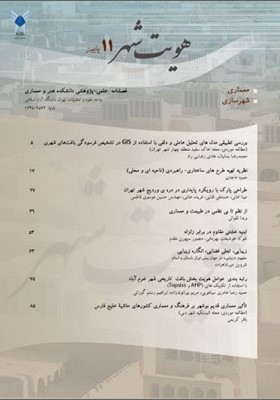بررسی تطبیقی مدلهای تحلیل عاملی و دلفی با استفاده از GIS در تشخیص فرسودگی بافتهای شهری مطالعه موردی: محله خاک سفید منطقه چهار شهر تهران
محورهای موضوعی : معماریدکترمحمدرضا بمانیان 1 , هادی رضایی راد 2
1 -
2 -
کلید واژه:
چکیده مقاله :
شهرها مانند موجودات زنده، حیات دارند و اگر در بستر زمان، عوامل برهمزننده تعادل زیستی آنها کنترل نشود، زمینههای زوالشان پدید میآید. یکی ازاین عوامل برهمزننده، فرسودگی کالبدی بافت ها است. همچنین گسترش روزافزون شهرها و تنوع دادهها، کنترل کلانشهرها را با معضلات اساسی روبرو نموده است. دراین میان سیستم اطلاعات مکانبا دو ویژگی مدیریت و تحلیل دادهها میتواند در این زمینه راهگشا باشد. هدف از این پژوهش بهطور کلی تشخیص بافتهای فرسوده کالبدی و تعیین اولویتهای مداخله و بهطور جزیی کاربست مدل تحلیلعاملی و دلفی با استفاده از GIS میباشد. تحلیلعاملیبا توانمندی خود در خلاصهسازی تعداد زیاد شاخصها، و دلفیهم با اولویتبندی شاخصها براساس نظر کارشناسان برنامهریزان را دررسیدن بههدف هدایت میکنند. محلهی خاکسفید تهران بهسان مصداقی بارز و خصیصهنما، واجد پهنههای فرسوده میباشد. براین اساس خروجی ها نشان از آن دارد که هر دو مدل به میزان بالایی شبیه یکدیگر است و ضریبهمبستگی آنها 0.895 است.
Cities are like live creatures and have their own death and life, and if their biological equivalence doesn't get controlled through the time they might erode gradually. One of the factors disturbing this equivalence is deteriorated urban fabric and poor urban neighborhoods. These districts suffer from wide range of difficulties and problems such as social-cultural problems (social delinquency, cultural conflictions), Self-abandoned urban fabric (inappropriate aggregation, narrow pathways, inappropriate orientation), physical deterioration (inferior materials, inappropriate construction) and etc. on the other hand rapid growth of cities and variety of data has been making governing and controlling of cities difficult and problematic. However geographic information system (GIS) with two qualities of data managing and analyzing could be an efficient instrument for solving this problems. The other attribute of GIS is that it could be used to use different models which are helpful in many parts of urban affairs. Two models which could be used efficiently in this field are Factor Analyst and Delphi models. Factor Analyst with its capability of extracting some effective indicators from wide number of indicators assists the urban planning in shortening and extracting important factors and therefore in decision making. Delphi also by use of specialist's comments and ideas prioritize the indicators and sub indicates in recognizing deteriorated urban fabric. KhakSefid neighborhood in east part of Tehran, zone 4, is the case study of this research which is a neighborhood with unique characteristic such as small aggregation, extended deteriorated urban fabric, low price of residential land, high rate of low income population, mostly workers and labors. This neighborhood is an instance of mentioned neighborhoods, and demonstrates variety of social, cultural, and physical insufficiencies and problems. Therefore the aim of this research generally is defining deteriorated urban fabric from physical point of view and specifying priority of intervening in them, and specifically is how we could apply Factor Analyst and Delphi models by use of geographic information system, also finding correlation and relation between this two models. This research uses 9 indicators affecting the deterioration of urban fabric for analyzing this neighborhood, although the final indicators which are used in these models might be different in different places and it should be chosen according to the context of a specific place. Outputs of Factor Analyst and Delphi models by use of geographic information system, in form of vector and raster colored maps that each color shows appropriate level of intervention, indicates that both models approximately define common districts as districts for possible intervention. Correlation coefficient of these two models is 0.895 and determination coefficient of them is 0.8, also outputs of both are same in acceptable extent. Therefore using scientific methods and mathematic logic like Factor Analyst by use of GIS, with considering current situation of each fabric, could help the specialist in specifying deteriorated urban fabric; it could also help defining level and type of intervention in each region. One other important attribute of this model is feasibility of extension of this method to other cities of Iran.
_||_

